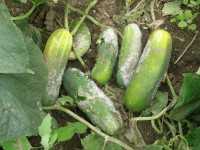Controlling Phytophthora And Downy Mildew In Cucumbers

As most growers know, downy mildew can cause tremendous loss in a short amount of time in a variety of crops. Another potential problem for numerous vegetables is Phytophthora crown, root, and fruit rot, which is caused by the soilborne fungus, Phytophthora capsici. This pathogen can survive in the soil for more than 10 years without a susceptible host.
When it comes to producing cucumbers, specifically, how are growers combating these diseases? AVG talked with Mary Hausbeck, a professor and Extension specialist in the Department of Plant, Soil, and Microbial Sciences at Michigan State University, to find out about the latest control options and get some advice on how to proceed in the future.
Q. What are some of the latest advances in controlling these two diseases on cucumbers?
Mary Hausbeck: For Phytophthora, our research has demonstrated the cucumber fruit must be protected at a very young age. When we first started our research, the industry was treating the foliage with fungicides prior to tip over. Our research showed that fungicides on cucumbers for Phytophthora are not needed prior to fruit production. Timing the fungicides for fruit protection must occur when the fruit are at 1 inch, 3 inches, and 5 inches in length.
Further, the fungicides must penetrate the foliage to reach the fruit with good coverage. Our research has shown that there are very effective fungicides available now that can be used to protect the fruit and that a couple of experimental products that are not yet registered (but are in the IR-4 pipeline) will be fabulous tools to protect cucumber fruit from Phytophthora in the future.
Results from our downy mildew research have begun to describe this pathogen as it occurs in different areas of the U.S. For instance, we now understand that the cucurbit downy mildew that occurs in the Michigan region has a different makeup to its population than that observed in the southeastern U.S. This may help explain differences that we see in these regions as far as which cucurbit types are most affected by the downy mildew disease. Perhaps this type of information will also be helpful in understanding differences that are emerging as far as fungicide effectiveness.
Of course, there is much more work that needs to be done in this area, but we’ve established a foundation to build on. Our research remains focused on delivering tools to the cucumber growers that include monitoring for influxes of sporangia (i.e. the airborne downy mildew seeds) into our primary Michigan growing regions. Also, new fungicides have been identified that are very effective against downy mildew. While some of these are registered, others are in the IR-4 pipeline. In some cases, a single fungicide product is effective against both downy mildew and Phytophthora. In other cases, a fungicide product may only work against downy mildew or Phytophthora, but not both.
Q. What is your advice to growers who have previously dealt with these two diseases on how to proceed in the future?
Hausbeck: Given that I’ve spent a lot of years in research and Extension, I’m a strong believer in the Land Grant system providing objective information to growers. With downy mildew and Phytophthora being somewhat of a “moving target” in the way that these pathogens can overcome fungicides, it is imperative that growers attend university Extension workshops that provide the latest information and research.
Finally, I would urge growers to ask questions. I love it when growers ask questions because it opens up my way of thinking and provides a new perspective. Also, it helps me to see how I can better present information so it is clear and, therefore, more helpful.










